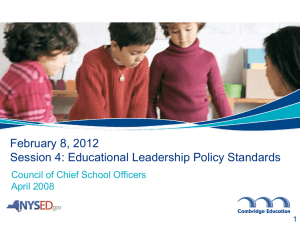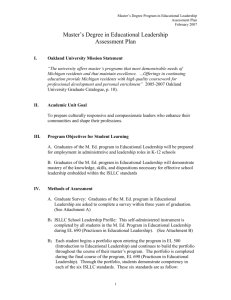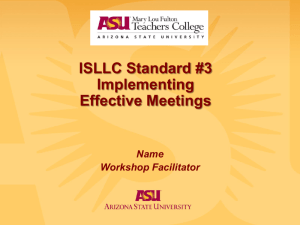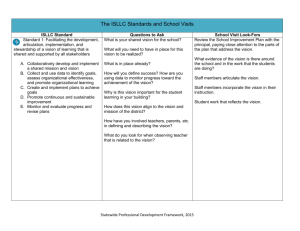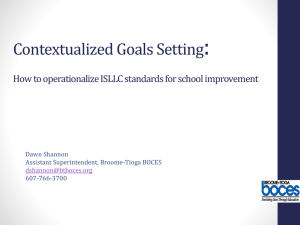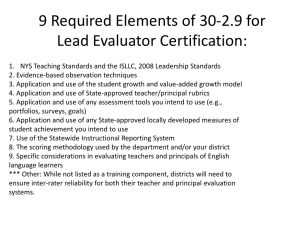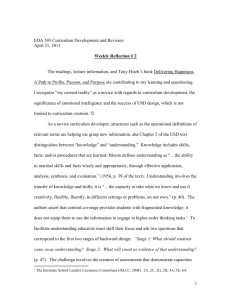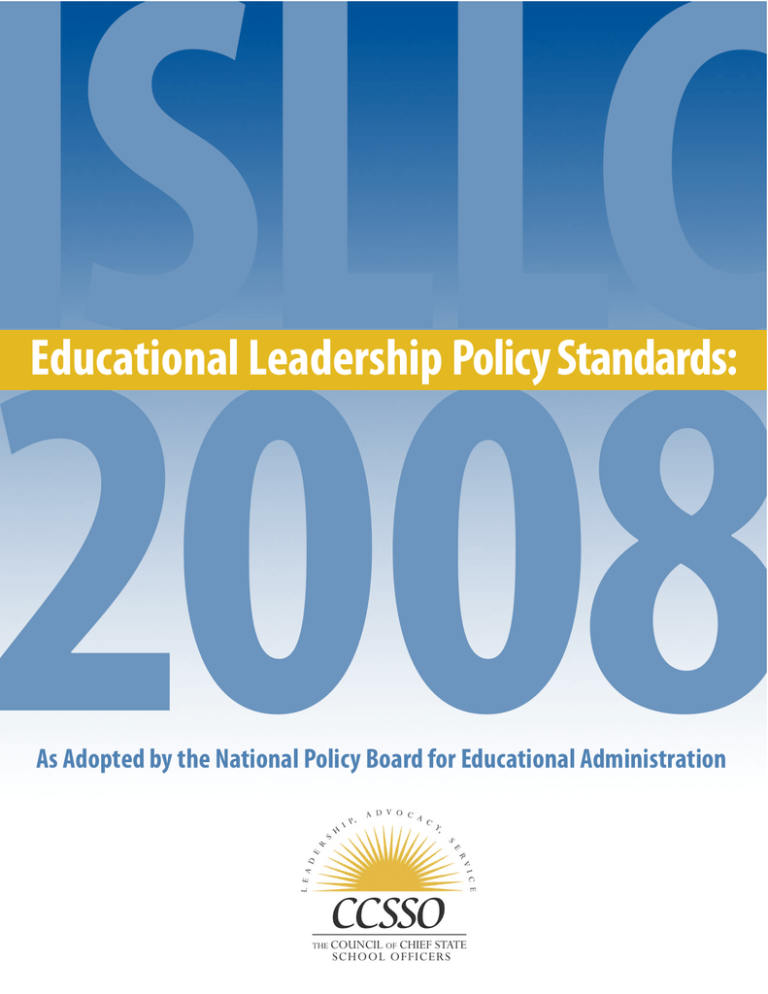
ISLLC
2008
Educational Leadership Policy Standards:
As Adopted by the National Policy Board for Educational Administration
Educational Leadership
Policy Standards: ISLLC 2008
As Adopted by the National Policy Board
for Educational Administration
Copyright © 2008 by the Council of Chief State School Officers, Washington, DC
Contributions made by the National Policy Board for Educational Administration
All rights reserved.
Council of Chief State School Officers
The Council of Chief State School Officers (CCSSO) is a nonpartisan, nationwide, nonprofit organization of public officials who head departments of
elementary and secondary education in the states, the District of Columbia,
the Department of Defense Education Activity, and five U.S. extra-state
jurisdictions. CCSSO provides leadership, advocacy, and technical assistance
on major educational issues. The Council seeks member consensus on
major educational issues and expresses their views to civic and professional
organizations, federal agencies, Congress, and the public.
Rick Melmer (South Dakota), President
Elizabeth Burmaster (Wisconsin), Past President
T. Kenneth James (Arkansas), President-Elect
Gene Wilhoit, Executive Director
One Massachusetts Avenue, NW, Suite 700
Washington, DC 20001-1431
Phone (202) 336-7000
Fax (202) 408-8072
www.ccsso.org
National Policy Board for Educational Administration
The following organizations and councils are members of the National
Policy Board for Educational Administration (NPBEA): American Association
of Colleges for Teacher Education, American Association of School
Administrators, Association for Supervision and Curriculum Development,
Council of Chief State School Officers, National Association of Elementary
School Principals, National Association of Secondary School Principals,
National Council for Accreditation of Teacher Education, National Council
of Professors of Educational Administration, National School Boards
Association, and University Council for Educational Administration.
For the past two years, the NPBEA Interstate School Leaders Licensure
Consortium (ISLLC) Steering Committee has been revising the ISLLC
Standards. This steering committee asked each NPBEA organization to
obtain input from its respective constituencies regarding the revision of the
ISLLC Standards. The NPBEA/ISLLC Steering Committee also created a
national Research Panel that identified the research base for updating these
ISLLC Standards. This document presents the updated standards, explains
the research behind the revisions, and provides other material explaining
how the policy standards can be used.
The Wallace Foundation
The Wallace Foundation supported the development of Educational
Leadership Policy Standards: ISLLC 2008 as part of its long-term commitment
to develop and share knowledge, ideas, and insights aimed at increasing
understanding of how education leadership can contribute to improved
student learning. Many of the resources cited in this publication and other
materials on education leadership can be downloaded for free at
www.wallacefoundation.org.
Table of Contents
Foreword 1
I. Introduction 3
II. Policy Standards: Building a Better Vision for Leadership 5
III. Research Offers New Insight on Education Leadership 9
IV. A Comprehensive Strategy to Improve Education Leadership 11
V. Educational Leadership Policy Standards 14
VI. Making the Standards Work 16
Appendix 1: Comparing ISLLC 1996 and ISLLC 2008 18
Appendix 2: ISLLC 2008 at a Glance 19
Appendix 3: Glossary of Terms 20
Acknowledgements
NPBEA Members 21
NPBEA/ISLLC Steering Committee Members 22
NPBEA Research Panel Members 23
Bibliography 24
To review the extensive collection of research that was studied during the development of the policy
standards and additional research conducted subsequent to this work, please go to:
www. ccsso.org/ISLLC2008Research
Dear Colleagues:
We are very pleased to announce the publication of Educational Leadership Policy Standards:
ISLLC 2008, as adopted by the National Policy Board for Educational Administration (NPBEA).
We have been privileged over the past two years to co-chair NPBEA’s Steering Committee.
Convened by NPBEA (the member organizations are listed on page 21) in response to requests
from our constituents for updated leadership standards, the Steering Committee developed
and guided a process for updating the 1996 Interstate School Leaders Licensure Consortium
(ISLLC) Standards for School Leaders. We relied heavily on professional groups and stakeholders
throughout the process, and the new standards are the result of this national collaboration. They
incorporate what has been learned about education leadership in the past decade and address
the changing policy context of American education.
These standards retain the structure or “footprint” of the six original ISLLC Standards, but
they are written for new purposes and audiences. Educational Leadership Policy Standards: ISLLC
2008 reinforces the proposition in the original ISLLC Standards that leaders’ primary responsibility is to improve teaching and learning for all children. However, the updated standards are
explicitly policy-oriented because the 1996 ISLLC Standards for School Leaders have been so
widely used as a model for state education leadership policies.
We are committed to gathering reactions to and learning from experience with these new
policy standards in order to keep them vibrant in the ever-changing education policy arena.
We encourage you to contact your respective organizational representatives with your feedback
on Educational Leadership Policy Standards: ISLLC 2008. These standards are intended to enhance
the field by stimulating dialogue about a new conception of education leadership that will
improve policies and practices nationwide.
Sincerely,
Richard A. Flanary
Joseph H. Simpson
Co-Chair, NPBEA Steering Committee
Co-Chair, NPBEA Steering Committee
Foreword
By Gene Wilhoit
Executive Director, CCSSO
Education leadership is more important than
research on education leadership conducted
ever. States recognize that schools and dis-
over the past decade, while Part IV explains
tricts will not meet demanding requirements
how policy standards form the foundation
for improving achievement without effective
for a continuum of policies and activities that
leaders. This publication, Educational
guide education leaders throughout their
Leadership Policy Standards: ISLLC 2008,
careers. Part V presents the new policy
represents the latest set of high-level policy
standards for education leadership. It
provides guidance to state policymakers as
they work to improve education leadership
preparation, licensure, evaluation, and
professional development.
As adopted by the National Policy Board
These standards reflect the new
information and lessons learned
about education leadership.
standards, while Part VI describes specific
activities, such as leadership academies and
for Educational Administration (NPBEA),
professional development, that can be
these standards reflect the wealth of new
guided by ISLLC 2008.
information and lessons learned about
This standards document builds on the
education leadership over the past decade.
Council of Chief State School Officers’
This document, which introduces the
tradition of leadership in this area. The
Educational Leadership Policy Standards:
Interstate School Leaders Licensure Consortium
ISLLC 2008 (hereafter referred to as ISLLC
(ISLLC) Standards for School Leaders (hereafter
2008), shows the importance of policy
referred to as ISLLC 1996) were written by
standards to leadership-related activities.
representatives from states and professional
Part I discusses the high-profile demands
associations in a partnership with NPBEA in
placed on education leaders to raise student
1994–95, supported by grants from the
achievement and the role that policy
Pew Charitable Trusts and the Danforth
standards can play in helping them meet
Foundation. The standards were published
these growing expectations. Part II describes
by CCSSO in 1996.
the differences between ISLLC 2008 and the
Recognizing the importance of updating
original leadership standards, reviews the
that work, The Wallace Foundation provided
updating process, and makes the case for the
support to review the growing base of
development of the new policy standards.
research on education leadership and to
Part III describes some of the highlights from
disseminate ISLLC 2008.
EDUCATIONAL LEADERSHIP POLICY STANDARDS: ISLLC 2008
1
While it was clear that school leaders were
essential to the smooth and efficient opera-
entirety or as a template for developing their
tion of schools, when the 1996 standards
own standards. With these guiding standards
were developed there was little research or
in place, states have been much more
consensus on the characteristics of good
successful in addressing school leadership
school leaders, the role principals play in
and needs at each stage of an education
raising student achievement, and the best
leader’s career.
policies and practices for expanding the
nation’s pool of effective administrators.
In developing the new standards, NPBEA
These much-anticipated updated policy
standards would not have been possible
without the tireless dedication of several
consulted with policy-oriented, practitioner-
groups and individuals. For over ten years,
based organizations, researchers, higher
they have dedicated themselves to improv-
education officials, and leaders in the field.
ing the leadership of our nation’s schools.
NPBEA also worked with a panel of scholars
States should review the new policy stan-
and experts in education administration to
dards and use them to shape, develop, and
identify the research base for updating
help implement the policies and practices
ISLLC 1996—research that previously did
that will give our nation’s children the leaders
not exist.
they need and deserve to succeed in the 21st
These standards helped lay the foundation
century. Most states have made important
necessary for states to develop—and be
progress toward improving their school
more informed as they built and supported
leaders, but more work needs to be done,
—various levels of the educator system, from
particularly to support and train leaders at all
preparation and induction to professional
stages along the career continuum. We
development and performance evaluation.
believe these policy standards will provide
Since then, 43 states have used the 1996
2
ISLLC Standards for School Leaders in their
EDUCATIONAL LEADERSHIP POLICY STANDARDS: ISLLC 2008
the foundation for this work.
I.
Introduction
Over the past decade, dramatic changes have
from ‘whether’ leadership really matters or is
put education leadership at the forefront
worth the investment, to ‘how’ to train, place,
of education policy research and debate.
and support high-quality leadership where
Research has taught us that school leaders
it’s needed the most: in the schools and
are crucial to improving instruction and
districts where failure remains at epidemic
raising student achievement. At the policy
levels,” wrote Wallace Foundation President
level, school performance measures have
M. Christine DeVita in A Bridge to School
been codified in state and federal law to hold
Reform. Unfortunately, the same report also
schools increasingly accountable for raising
noted that “states are only beginning to put
student achievement among students from
all population subgroups. At the same time,
schools are under pressure to produce high
school graduates who are better trained
and who can adapt to an ever-changing
workplace.
These mounting demands are rewriting
administrators’ job descriptions every year,
making them more complex than ever.
ISLLC 2008 keeps the “footprint” of the
original ISLLC standards, but is written
for new purposes and audiences.
together coherent systems that reliably
achieve the goal of placing an appropriate,
well-trained principal in every school.”
Fortunately, the last decade has produced
Today, education leaders must not only
more research than ever about education
manage school finances, keep buses running
leadership and the role that school leaders
on time, and make hiring decisions, but they
can and should play in raising student
must also be instructional leaders, data
achievement. One of the clearest lessons
analysts, community relations officers, and
from this research is that the states that are
change agents. They have to be able to
using education leadership standards are on
mobilize staff and employ all the tools in an
the right track. According to an extensive
expanded toolbox.
review of the research literature funded by
Clear and consistent standards can help
The Wallace Foundation, goal- and vision-
them do this. ISLLC 2008 will help state policy-
setting, which are articulated in the stan-
makers strengthen selection, preparation,
dards, are areas in which education leaders
licensure, and professional development for
can have the most impact. Standards and
education leaders—giving these leaders the
other guidelines have been shown to be
tools they need to meet new demands.
essential tools in developing effective
“The national conversation has shifted
pre-service training programs for principals.
EDUCATIONAL LEADERSHIP POLICY STANDARDS: ISLLC 2008
3
Therefore, incorporating clear and consistent
educator development. Standards are the
standards and expectations into a statewide
foundation and can inform all components of
education system can be a core predictor of
an aligned and cohesive system—prepara-
strong school leadership.
tion, licensing, induction, and professional
Drawing on this new knowledge allows
development. They can help states set expec-
policymakers and educators to devote more
tations for licensure, guide improvements in
time and energy to strategies that have been
administrator preparation programs at
shown to work. ISLLC 2008 is meant to serve
colleges and universities, and influence the
process for screening and hiring leaders, even
at the level of local school boards. Just as
importantly, they can set parameters for
developing assessment instruments, practice
standards, and professional development to
facilitate performance growth toward
expert practice.
Additionally, they can inform state policies, not just for those coming into the field,
but for all leaders as they move through their
careers. These standards can help to further
clarify expectations for professional development and the performance of veteran
principals. Ultimately, the standards can help
states create a seamless set of supporting
policies and activities that span the career
continuum of an education leader.
This document presents the newly
as a foundational piece for policymakers as
adopted NPBEA standards coupled with the
they assess current goals, regulations,
growing research base available on educa-
policies, and practices of education leaders.
tion leadership and suggestions for how
These policy standards can be used by
policymakers to think about their system of
4
EDUCATIONAL LEADERSHIP POLICY STANDARDS: ISLLC 2008
standards can help serve as the foundation of
an entire system of educator development.
II.
Policy Standards:
Building a Better Vision for Leadership
ISLLC 2008 is designed to serve as a broad set
●
How does a district or school evaluate
of national guidelines that states can use
the skills and dispositions of a candidate
as a model for developing or updating their
to improve student performance?
own standards. These standards provide
●
How does one evaluate appropriate
high-level guidance and insight about the
continuing education programs or
traits, functions of work, and responsibilities
mentoring of new principals?
they will ask of their school and district
leaders. Using the policy standards as a
●
How does one evaluate existing school
leaders in meeting accountability goals?
foundation, states can create a common
language and bring consistency to education
Responding to the Field
leadership policy at all levels so that there
In the fast-changing education policy envi-
are clear expectations.
ronment, a set of standards is only as good as
Gene Wilhoit, the executive director of the
the input on which it is based. ISLLC 2008
Council of Chief State School Officers,
addresses changes in the field and responds
describes policy standards as the first step
to input from practitioners and policy
toward creating comprehensive, locally
leaders. Among the concerns addressed is
tailored approaches for developing and
retaining high-quality leaders. The ultimate
goal of these standards, as with any set of
education standards, is to raise student
achievement. These standards contribute to
this effort by improving coordination among
policymakers, education leaders, and
These standards provide high-level
guidance and insight about the
traits, functions of work, and
responsibilities expected of school
and district leaders.
organizations. They do this by beginning to
answer questions such as:
●
●
the fact that the 1996 standards were too
How do schools of education know what
restrictive, as the very nature of listing
education leaders need to know as it
examples of leadership indicators was
relates to every child meeting academic
unintentionally limiting and negated other
achievement standards?
areas that could have been included in an
How can schools of education effectively
exhaustive listing.
convey that knowledge in a coherent
fashion?
The new standards also respond to
concerns that the 1996 standards “froze”
leadership preparation programs.
EDUCATIONAL LEADERSHIP POLICY STANDARDS: ISLLC 2008
5
ISLLC 2008 is intended to encourage more
recommendations regarding how the policy
flexibility in how leadership preparation
standards in this publication can be used to
programs define and view leadership. Also,
influence leadership practice and policy.
by providing a representative sample of
Other points of comparison between ISLLC
empirical research, the new standards
1996 and ISLLC 2008 include:
provide background material that was not
●
contained in the 1996 standards.
“broad standards” are similar, yet not
The most fundamental change, however,
responds to the recognition that when
The language and framework of the six
identical.
●
“Indicators” are not listed in the revised
implementing the 1996 standards, some
policy standards as they were in the 1996
institutions used them differently, confusing
version. Policy standards are there to set
policy standards with practice standards
overall guidance and vision.
and/or program standards. Consequently,
●
Significantly, “functions” that define each
this document states unequivocally, in its title
standard have been added to replace the
and elsewhere, that the standards here are
knowledge, skills, and dispositions. It is
policy standards and are designed to be
here that research findings and feedback
discussed at the policymaking level to set
from NPBEA and its members are
policy and vision. NPBEA and other organiza-
addressed.
tions also are engaged in efforts to make
Improving Leadership Standards
Educational Leadership Policy Standards: ISLLC 2008 organizes the functions that help
define strong school leadership under six standards. These standards represent the broad,
high-priority themes that education leaders must address in order to promote the success
of every student. These six standards call for:
1.
Setting a widely shared vision for learning;
2.
Developing a school culture and instructional program conducive to student learning
and staff professional growth;
3.
Ensuring effective management of the organization, operation, and resources for a
safe, efficient, and effective learning environment;
4.
Collaborating with faculty and community members, responding to diverse
community interests and needs, and mobilizing community resources;
5.
Acting with integrity, fairness, and in an ethical manner; and
6.
Understanding, responding to, and influencing the political, social, legal, and
cultural contexts.
6
EDUCATIONAL LEADERSHIP POLICY STANDARDS: ISLLC 2008
●
While the titles of the standards and this
research identified and the interest in design-
publication have been changed to make
ing an interactive forum that can be regularly
clear that they are policy standards, the
updated by researchers and practitioners,
“ISLLC” moniker remains. Because so
this information has been compiled into a
many states have adopted the ISLLC
database now available online at
standards in one form or another, it is
www.ccsso.org/ISLLC2008Research.
important to maintain this link.
The initial research base, identified by the
NPBEA research panel, contains empirical
Developing the Policy Standards
research reports as well as policy analyses,
The new standards flow from a two-year
revision process led by NPBEA. In revising
ISLLC 1996, NPBEA consulted with its member
organizations (see member list on page 21)
and other policy-oriented, practitioner-based
organizations, researchers, higher education
officials, and leaders in the field. Additionally,
NPBEA created a panel of scholars and
experts in education administration to
identify the research base for updating ISLLC
1996—a majority of this research did not
exist when those original standards were
published.
The NPBEA/ISLLC Steering Committee (see
page 22 for a complete list) carried out its
work in several phases. Each NPBEA member
organization identified a strategy to obtain
membership input regarding the revision of
ISLLC 1996. Once a draft of the revised
standards was complete, the NPBEA
Steering Committee distributed copies to
and gathered feedback from NPBEA member
organizations, other professional groups, and
leadership texts, and other resources
the research panel.
considered to be “craft knowledge” and
The research panel was charged with
identifying a research base for updating ISLLC
“sources of authority” in the field.
Based on this extensive process of input
1996 and for users of the updated standards.
and feedback, the NPBEA Steering Commit-
Because of the extensive nature of the
tee revised drafts and finalized ISLLC 2008,
EDUCATIONAL LEADERSHIP POLICY STANDARDS: ISLLC 2008
7
recommending the standards for adoption
by the NPBEA Executive Board.
Starting in January 2008, NPBEA began
The policy standards in this publication
will form the foundation for further thought,
research, dialogue, and debate on creating
updating the Educational Leadership
standards and guidelines that specifically
Constituent Council (ELCC) Program
meet the needs of practitioners. The intent
Standards, which are used by the National
of NPBEA is to continue to refine the process
Council for Accreditation of Teacher Educa-
of policy standard revision so that the
tion (NCATE) to review preparation programs
standards reflect changes in the knowledge
in education leadership. The 2002 ELCC
base. ISLLC 2008 will serve as a catalyst for
Program Standards are based on the original
research efforts to study the implementation
ISLLC 1996. Updating them will contribute
and effects of these policy standards and
to a coherent vision and system of leadership
the program and practice expectations
that can guide state policies and
aligned with or resulting from the policy
leadership programs.
standards.
Setting the Stage for ISLLC 2008
The following principles set the direction and priorities during the development of
the new policy standards:
1.
Reflect the centrality of student learning;
2.
Acknowledge the changing role of the school leader;
3.
Recognize the collaborative nature of school leadership;
4.
Improve the quality of the profession;
5.
Inform performance-based systems of assessment and evaluation for school leaders;
6.
Demonstrate integration and coherence; and
7.
Advance access, opportunity, and empowerment for all members of the school
community.
8
EDUCATIONAL LEADERSHIP POLICY STANDARDS: ISLLC 2008
III.
Research Offers New Insight
on Education Leadership
As noted in The Wallace Foundation 2007
In How Leadership Influences Student Learning,
report, A Bridge to School Reform, until
they report that direct and indirect leader-
recently there was little evidence about what
ship effects account for about one-quarter of
effective education leadership looks like and
total school effects on student learning.
the best ways to evaluate this leadership.
Effective principals and school administra-
In the past decade, a new research literature
tors set the organizational direction and
has filled this void. The research has drawn
culture that influences how their teachers
attention to the crucial connection between
perform. According to How Leadership
school leadership and student achievement.
It gives state officials, education leaders, and
the institutions that train school leaders new
resources to guide their standards, policies,
and practices.
ISLLC 2008 reflects the input of over 100
Studies find leadership is second
only to classroom instruction in
influencing student outcomes.
Influences Student Learning, the category
research projects and studies, which helped
called “setting directions” is the area in which
guide the standards revision process and,
education leaders have the greatest impact,
ultimately, influence the standards presented
as the goals and sense of purpose they
in this document.
provide strengthens the entire staff.
Strong education leaders also attract,
Effective Leaders Promote
Better Teaching
retain, and get the most out of talented
This research consistently points out that
reviews, Leithwood and his colleagues
states and districts are right to focus on stan-
judged the research supporting this
dards for education leaders. School leaders
conclusion “substantial” and that effective
are critical to helping improve student
education leaders can enhance teachers’
performance. Research now shows that
performance by providing targeted support,
leadership is second only to classroom
modeling best practice, and offering
instruction among school-related factors that
intellectual stimulation.
influence student outcomes, according to an
teachers. Drawing on previous research
Research also finds that successful leader-
extensive review of the research literature
ship preparation programs—particularly
conducted in 2004 by Kenneth Leithwood,
those that train principals who are willing
Karen Seashore Louis, Stephen Anderson,
and able to work in our most challenging
and Kyla Wahlstrom.
schools—are modeled and organized around
EDUCATIONAL LEADERSHIP POLICY STANDARDS: ISLLC 2008
9
clear goals for systemwide values and
Making the Connections Among State, District
learning. A 2007 report by Linda Darling-
and School Policies and Practices (2006), there
Hammond and colleagues at Stanford
are three core system elements (namely
University found that exemplary pre- and
standards, training, and conditions) that
in-service development programs for
determine the quality of school leadership.
principals have many common components,
Adequate training and the right mix of
including “a comprehensive and coherent
incentives and conditions are needed to help
curriculum aligned to state and professional
facilitate strong leadership. But the most
standards, in particular the NCATE/Interstate
important element is “standards that spell
School Leaders Licensure Consortium (ISLLC)
out clear expectations about what leaders
standards, which emphasize instructional
need to know and do to improve instruction
leadership.”
and learning and that form the basis for
According to Leadership for Learning:
10
EDUCATIONAL LEADERSHIP POLICY STANDARDS: ISLLC 2008
holding them accountable for results.”
IV.
A Comprehensive Strategy
to Improve Education Leadership
ISLLC 2008 should be the starting point for
Training Programs with Established
future thought, research, dialogue, and
Performance Expectations
debate about standards for school leaders.
Serving as a foundation, these policy
CCSSO and NPBEA envision these standards
standards are well poised to influence and
as the foundation for a comprehensive
drive training and preparation programs.
framework that addresses each stage of an
ISLLC 2008 plays out at the preparation
education leader’s career. The new policy
program level by establishing performance
standards build on ISLLC 1996 and
expectations and lends itself to aid in and can
complement other standards and expecta-
facilitate curriculum development, candidate
tions related to education leadership.
assessment, and accountability. Certainly
As a set of policy standards, ISLLC 2008
ISLLC 2008 is already informing the NCATE
offers high-level guidance to policymakers
accreditation process and the program
and education leaders as they set goals and
standards that guide NCATE’s work. In 2002,
design their own standards. Because
the NPBEA-appointed Educational Leader-
improving student achievement at the state
ship Constituent Council released Standards
level requires coordinated policies to
for Advanced Programs in Educational Leader-
cultivate excellent leadership at the school
ship; they are now reviewing those standards
and district levels, policy standards establish
so that they will be aligned with ISLLC 2008.
common goals for policymakers and
The CCSSO State Consortium on Education
organizations as they form policies regarding
Leadership (SCEL) will release in the spring of
school leadership and set statewide goals for
2008 Performance Expectations and Indicators
school leadership development.
for Education Leaders: A Companion Guide to
These policy standards were updated to
the Educational Leadership Policy Standards—
provide a framework for policy creation,
ISLLC 2008. Describing those expectations
training program performance, life-long
through dispositions, elements, and
career development, and system support.
indicators will help to operationalize the
Given their broad nature, they can influence
policy standards at a more granular level.
and drive many system supports and
changes which will ultimately lead to
effective instructional leadership that
Licensing and Induction
In turn, ISLLC 2008 can inform licensing
positively impacts student achievement
and induction programs, which assess new
(please refer to graphic on page 13).
leader professional knowledge. This helps to
ensure that the new leaders in the system can
EDUCATIONAL LEADERSHIP POLICY STANDARDS: ISLLC 2008
11
demonstrate adequate professional knowl-
Performance-Based Principal Evaluation. These
edge before moving into their position. These
evaluations, developed collaboratively by
policy standards are an anchor and will help
the Missouri Department of Elementary
states formulate in very concrete and direct
and Secondary Education and the state’s
terms what they expect of their school
17 preparation institutions, set out what
leaders entering the profession.
high-quality education leadership looks like
and what school and district leaders must
Evaluating Performance
be able to do. Missouri has shown that policy
States additionally have the ability to set
standards can form the basis for ongoing
guidelines for evaluating performance of
professional development throughout the
their school leaders and can use ISLLC 2008 as
career continuum. They allow one to think
a basis for this work. These evaluative
about continuous improvement through
measures must be performance-based and
high-quality career development and
can more readily formalize what is expected
planning. Taken to a different level of
of each leader in the system. Many states
granularity, these standards can also serve
have successfully implemented assessment
as a basis for developing descriptors
structures to ensure that there are resources
of practice from aspiring to retiring.
in place to continually evaluate leaders’
performance. The Wallace Foundation has
Improving Working Conditions
funded a large evaluation effort with
As articulated previously, ISLLC 2008 is
Vanderbilt University. In the fall of 2008, the
designed to provide a framework and
Vanderbilt Assessment of Leadership in
foundation as each state develops and aligns
Education (Val-Ed) will be available. It was
its expectations for education leaders. As
developed in recognition that leader assess-
states and districts work toward all of these
ment is an important step in evaluating
improvements, they must also consider
school performance and is a key determinant
improving working conditions. ISLLC 2008 can
of student success. Linking the assessment to
drive and influence how one aligns and
ISLLC 2008 helps states, districts, and schools
assigns roles, responsibilities, and authority.
create an aligned performance-based system.
They can also form the basis for implementing incentives for leaders to choose certain
12
Supporting Leaders Throughout
positions in specific locations. They can
the Career Continuum
additionally serve as the foundation in devel-
Many states have recognized the need for
oping an advanced professional certification
continuing evaluation. Missouri, for example
for leaders. Making systemwide changes to
has developed the Performance-Based
the work environment can certainly help
Superintendent Evaluation and the
leaders meet their professional goals.
EDUCATIONAL LEADERSHIP POLICY STANDARDS: ISLLC 2008
V.
Educational Leadership Policy Standards
Educational
Leadership
Policy Standards:
ISLLC 2008
as adopted by
the National Policy
Board for Educational
Administration
(NPBEA) on
December 12, 2007.
Standard1:1
Standard
An education leader promotes the success of every student by facilitating the development,
articulation, implementation, and stewardship of a vision of learning that is shared and
supported by all stakeholders.
Functions:
A. Collaboratively develop and implement a shared vision and mission
B.
Collect and use data to identify goals, assess organizational effectiveness, and promote
organizational learning
C.
Create and implement plans to achieve goals
D. Promote continuous and sustainable improvement
E.
Monitor and evaluate progress and revise plans
Standard1:2
Standard
An education leader promotes the success of every student by advocating, nurturing, and
sustaining a school culture and instructional program conducive to student learning and staff
professional growth.
Functions:
A. Nurture and sustain a culture of collaboration, trust, learning, and high expectations
B.
Create a comprehensive, rigorous, and coherent curricular program
C.
Create a personalized and motivating learning environment for students
D. Supervise instruction
E.
Develop assessment and accountability systems to monitor student progress
F.
Develop the instructional and leadership capacity of staff
G. Maximize time spent on quality instruction
H. Promote the use of the most effective and appropriate technologies to support teaching
and learning
I.
Monitor and evaluate the impact of the instructional program
Standard1:3
Standard
An education leader promotes the success of every student by ensuring management of the
organization, operation, and resources for a safe, efficient, and effective learning environment.
Functions:
A. Monitor and evaluate the management and operational systems
B.
Obtain, allocate, align, and efficiently utilize human, fiscal, and technological resources
C.
Promote and protect the welfare and safety of students and staff
D. Develop the capacity for distributed leadership
E.
Ensure teacher and organizational time is focused to support quality instruction and
student learning
14
EDUCATIONAL LEADERSHIP POLICY STANDARDS: ISLLC 2008
Standard1:4
Standard
An education leader promotes the success of every student by collaborating with faculty and
community members, responding to diverse community interests and needs, and mobilizing
community resources.
Functions:
A. Collect and analyze data and information pertinent to the educational environment
B.
Promote understanding, appreciation, and use of the community’s diverse cultural, social,
and intellectual resources
C.
Build and sustain positive relationships with families and caregivers
D. Build and sustain productive relationships with community partners
Standard1:5
Standard
An education leader promotes the success of every student by acting with integrity, fairness,
and in an ethical manner.
Functions:
A. Ensure a system of accountability for every student’s academic and social success
B.
Model principles of self-awareness, reflective practice, transparency, and ethical behavior
C.
Safeguard the values of democracy, equity, and diversity
D. Consider and evaluate the potential moral and legal consequences of decision-making
E.
Promote social justice and ensure that individual student needs inform all aspects of
schooling
Standard1:6
Standard
An education leader promotes the success of every student by understanding, responding to,
and influencing the political, social, economic, legal, and cultural context.
Functions:
A. Advocate for children, families, and caregivers
B.
Act to influence local, district, state, and national decisions affecting student learning
C.
Assess, analyze, and anticipate emerging trends and initiatives in order to adapt
leadership strategies
EDUCATIONAL LEADERSHIP POLICY STANDARDS: ISLLC 2008
15
VI.
Making the Standards Work
Educational Leadership Policy Standards:
the system. Just as importantly, they can set
ISLLC 2008 is now ready for state policymak-
parameters for developing professional
ers to adopt or adapt as they develop
development and evaluation systems that
coherent education leadership policies that
can readily facilitate performance growth of
promote student success. These standards
all education leaders. By and large, states
are the first step toward creating innovative
have yet to evaluate performance assess-
policies and programs that ensure our invest-
ments for education leaders against policy
ments of time and resources deliver the best
standards—this is a promising area for
possible results for our schools.
pioneering states.
Ensuring that the standards are used at
different levels of education leadership to
Guidance for Leadership
influence student achievement should be the
Academy Activities
primary goal for policymakers. By painting a
New, comprehensive systems of education
portrait of effective education leadership—
leadership standards are only as good as their
the traits and objectives that all education
implementation. To ensure that these
leaders should share—the standards enable
standards improve education leadership
state policymakers to guide improvements.
statewide, policymakers should consider
While Part IV described in more general terms
creating or expanding leadership academies
how these standards can drive and influence
for school and district leaders. These acade-
different parts of the educator development
mies create opportunities to bring together
system, here are some specific examples in
faculty members from leadership preparation
making standards work.
programs throughout a particular state and
improve the coordination and consistency of
16
Setting Common Expectations
expectations for education leaders. For
As a national standards document, ISLLC
example, Missouri’s Department of Elemen-
2008 can help state leaders create a common
tary and Secondary Education operates a
language when discussing expectations for
leadership academy in cooperation with
education leaders. They bring greater
university-based preparation programs that
consistency to education leadership policy,
provides standards-based evaluation and
while providing high-level guidance that can
professional development for education
serve as the foundation for other portions of
leaders.
EDUCATIONAL LEADERSHIP POLICY STANDARDS: ISLLC 2008
Improving Professional Development
Maximizing Returns for Student Results
The policy standards outlined in this publica-
By drawing on the latest research on educa-
tion can be used in evaluating current
tion leadership, these new standards orient
professional development offerings for
policymakers toward the most important
education leaders. Ohio’s Department of
aspects of education leadership, allowing
Education has collaborated with the state
them to maximize the impact of limited
elementary and secondary principals
resources on student achievement. State
associations to create a two-year induction
policymakers can adopt or adapt them into
program for new principals. Each new
statute and/or regulation. Chief state school
principal selects a content track for perform-
officers can work closely with governors and
ance-based professional development based
legislators to pass new standards and policies
on ISLLC 1996. However, states can do much
and allocate funding for implementation.
more to create standards-based mentoring
These standards can also provide greater
programs for educational leaders and
clarity to the public by outlining the
collect performance data that link areas of
expectations we should have for each and
weakness to professional learning plans
every leader.
for leaders.
ISLLC 2008 supports the role of principals
as instructional leaders and the importance
Strengthening State Systems
of sound education leadership at all levels to
States need to do more to comprehensively
raising student achievement—and offers
monitor and report the impact that prepara-
concrete policy recommendations that flow
tion and professional development programs
from these standards. As such, they are an
are having on the quality of education
important resource for guiding the next
leadership—ISLLC 2008 can help with this
generation of education leadership policies
task. Some states have taken initial steps:
and programs.
Delaware, for example, has developed assessments to report on preparation programs;
and Kentucky has commissioned validation
studies on certification exams. Standardsbased professional evaluation remains
an area ripe for additional development and
leadership by states.
EDUCATIONAL LEADERSHIP POLICY STANDARDS: ISLLC 2008
17
Appendix 1: Comparing ISLLC 1996 and ISLLC 2008
Changes made to the text of each standard are underlined below.
ISLLC Standards for School Leaders (1996)
Educational Leadership Policy Standards: ISLLC 2008
STANDARD 1:
STANDARD 1:
A school administrator is an educational leader who promotes
the success of all students by facilitating the development,
articulation, implementation, and stewardship of a vision of
learning that is shared and supported by the school community.
Knowledge, Skills & Dispositions: 29
STANDARD 2:
A school administrator is an educational leader who promotes
the success of all students by advocating, nurturing, and sustaining a school culture and instructional program conducive
to student learning and staff professional growth.
Knowledge, Skills & Dispositions: 39
STANDARD 3:
A school administrator is an educational leader who promotes
the success of all students by ensuring management of the
organization, operations, and resources for a safe, efficient,
and effective learning environment.
Knowledge, Skills & Dispositions: 38
STANDARD 4:
A school administrator is an educational leader who promotes
the success of all students by collaborating with families and
community members, responding to diverse community
interests and needs, and mobilizing community resources.
Knowledge, Skills & Dispositions: 29
STANDARD 5:
A school administrator is an educational leader who promotes
the success of all students by acting with integrity, fairness,
and in an ethical manner.
Knowledge, Skills & Dispositions: 29
STANDARD 6:
A school administrator is an educational leader who promotes
the success of all students by understanding, responding to,
and influencing the larger political, social, economic, legal,
and cultural context.
Knowledge, Skills & Dispositions: 19
18
EDUCATIONAL LEADERSHIP POLICY STANDARDS: ISLLC 2008
An education leader promotes the success of every student
by facilitating the development, articulation,
implementation, and stewardship of a vision of learning
that is shared and supported by all stakeholders.
Functions: 5
STANDARD 2:
STANDARD 3:
STANDARD 4:
An education leader promotes the success of every student
by advocating, nurturing, and sustaining a school culture
and instructional program conducive to student learning
and staff professional growth.
Functions: 9
An education leader promotes the success of every student
by ensuring management of the organization, operations,
and resources for a safe, efficient, and effective learning
environment.
Functions: 5
An education leader promotes the success of every student
by collaborating with faculty and community members,
responding to diverse community interests and needs,
and mobilizing community resources.
Functions: 4
STANDARD 5:
STANDARD 6:
An education leader promotes the success of every student
by acting with integrity, fairness, and in an ethical manner.
Functions: 5
An education leader promotes the success of every student
by understanding, responding to, and influencing
the ** political, social, economic, legal, and cultural context.
Functions: 3
EDUCATIONAL LEADERSHIP POLICY STANDARDS: ISLLC 2008
19
A. Monitor and
evaluate the
management and
operational
systems
A. Collect and
analyze data and
information
pertinent to the
educational
environment
A. Ensure a system
of accountability
for every student’s
academic and
social success
A. Advocate for
B. Act to influence
children, families, local, district,
and caregivers
state, and
national decisions
affecting student
learning
Ensuring management of the
organization, operation, and
resources for a safe, efficient,
and effective learning
environment
Collaborating with faculty and
community members, responding
to diverse community interests
and needs, and mobilizing
community resources
Acting with integrity, fairness,
and in an ethical manner
Understanding, responding
to, and influencing the political,
social, economic, legal, and
cultural context
B. Model principles
of self-awareness,
reflective practice,
transparency, and
ethical behavior
B. Promote understanding, appreciation, and use of
the community’s
diverse cultural,
social, and intellectual resources
B. Obtain,
allocate, align,
and efficiently
utilize human,
fiscal, and technological resources
B. Create a
comprehensive,
rigorous, and
coherent
curricular
program
A. Nurture and
sustain a culture
of collaboration,
trust, learning,
and high
expectations
Advocating, nurturing, and
sustaining a school culture and
instructional program conducive
to student learning and staff
professional growth
C. Assess, analyze,
and anticipate
emerging trends
and initiatives in
order to adapt
leadership
strategies
C. Safeguard
the values of
democracy, equity,
and diversity
C. Build and
sustain positive
relationships with
families and
caregivers
C. Promote and
protect the
welfare and safety
of students
and staff
C. Create a
personalized and
motivating
learning environment for students
B. Collect and use C. Create and
data to identify
implement plans
goals, assess orga- to achieve goals
nizational effectiveness, and
promote organizational learning
A. Collaboratively
develop and
implement a
shared vision
and mission
Facilitating the development,
articulation, implementation,
and stewardship of a vision of
learning that is shared and
supported by all stakeholders
1
2
3
4
5
6
STANDARDS
D. Consider and
evaluate the
potential moral
and legal
consequences of
decision-making
D. Build and
sustain productive
relationships with
community
partners
D. Develop the
capacity for
distributed
leadership
D. Supervise
instruction
D. Promote
continuous and
sustainable
improvement
E. Promote social
justice and ensure
that individual
student needs
inform all aspects
of schooling
E. Ensure teacher
and organizational time is
focused to support
quality instruction
and student
learning
E. Develop assessment and
accountability
systems to
monitor student
progress
E. Monitor and
evaluate progress
and revise plans
F. Develop the
instructional and
leadership
capacity of staff
FUNCTIONS
G. Maximize time
spent on quality
instruction
An education leader promotes the success of every student by...
Educational Leadership Policy Standards: ISLLC 2008
Appendix 2: ISLLC 2008 at a Glance
H. Promote the
use of the most
effective and
appropriate
technologies to
support teaching
and learning
I. Monitor and
evaluate the
impact of the
instructional
program
Appendix 3: Glossary of Terms
Craft Knowledge: Abilities, awareness, infor-
Program Standards: Guide curriculum
mation, and other accumulated knowledge
planning, program and candidate assessment
based on field and classroom experience.
design, and implementation of the accreditation process for school building and district
Empirical: A type of evidence “gained from
leadership preparation programs at colleges
observation or experiment rather than
and universities undergoing NCATE
theory” (Source: Webster’s II: New Riverside
accreditation.
Dictionary).
Results: Outputs and outcomes achieved by
Function: The action or actions for which a
an organization.
person or thing is responsible.
Stakeholders: Individuals or groups that
Policy Standards: High-level, broad national
might be affected by a particular action
standards that policymakers and states use as
and/or activity.
a model for developing their own policy
standards. Policy standards are typically used
Standards: The knowledge and skills that
for visioning, policy development, and
should be mastered in order to achieve a
identifying general goals for education
level of proficiency in a particular area.
leaders.
Standards are also a means of setting criteria
for accomplishing or judging a particular
Practice Standards: Observable behaviors
activity or event.
and actions required to meet performance
standards. They are measurable and can be
Systematic: Processes that are repeatable
used as guides to establish individual
and predictable, rather than anecdotal
performance goals, professional develop-
and episodic.
ment plans, and evaluation conferences
20
within a system of continuous improvement
Systemic: Interrelatedness and interdepend-
focused on expert performance.
ency of parts and people within the system.
EDUCATIONAL LEADERSHIP POLICY STANDARDS: ISLLC 2008
Acknowledgements
National Policy Board for Educational Administration (NPBEA) Members
NPBEA is committed to improving educational administration and practice by fostering models
for the preparation and professional development of educational leaders and improving
certification standards. The development of ISLLC 2008 was a product of the collaboration
among the leaders from each NPBEA membership organization.
American Association of Colleges for Teacher Education (AACTE)
Sharon P. Robinson, President and CEO
American Association of School Administrators (AASA)
Paul D. Houston, Executive Director
Association for Supervision and Curriculum Development (ASCD)
Gene R. Carter, Executive Director
Council of Chief State School Officers (CCSSO)
Gene Wilhoit, Executive Director
National Association of Elementary School Principals (NAESP)
Gail Connelly, Executive Director
National Association of Secondary School Principals (NASSP)
Gerald N. Tirozzi, Executive Director
National Council for Accreditation of Teacher Education (NCATE)
Arthur E. Wise, Executive Director
National Council of Professors of Educational Administration (NCPEA)
Gary Martin, Executive Director
National School Boards Association (NSBA)
Joseph S. Villani, Deputy Executive Director
University Council for Educational Administration (UCEA)
Michelle Young, Executive Director
EDUCATIONAL LEADERSHIP POLICY STANDARDS: ISLLC 2008
21
NPBEA/ISLLC Steering Committee Members
We would like to acknowledge and give special thanks to the committee members for sharing
their perspectives and ideas in the development of ISLLC 2008.
Richard Barbacane, Consultant
Global Education Association
Agnes Crawford, Assistant Executive Director
Association for Supervision and Curriculum Development (ASCD)
Honor Fede, ELCC, Associate Director
National Association of Secondary School Principals (NASSP)
Lew Finch, Superintendent in Residence
American Association of School Administrators (AASA)
Richard A. Flanary, Director of Professional Development Services
National Association of Secondary School Principals (NASSP)
Gary Martin, Executive Director
National Council of Professors of Educational Administration (NCPEA)
Northern Arizona University
Nona Prestine, Professor in Charge
Graduate Programs in Educational Leadership
The Pennsylvania State University (representing the University Council for
Educational Administration-UCEA)
Joe Simpson, Deputy Superintendent
Wyoming Department of Education
Carol Smith, Vice President for Professional Issues
American Association of Colleges for Teacher Education (AACTE)
22
EDUCATIONAL LEADERSHIP POLICY STANDARDS: ISLLC 2008
NPBEA Research Panel Members
A tremendous amount of research and resources underpins the 2008 policy standards
(www.ccsso.org/ISLLC2008Research). We would like to give special thanks to the members
of the research panel for their efforts in providing the relevant research. Joseph Murphy and
Rosemary Papalewis, co-chairs of this research panel, provided remarkable leadership in
this endeavor.
Colonel Arthur J. Athens, USMCR
Department of Leadership, Ethics, and Law, U.S. Naval Academy
Nelda Cambron-McCabe, Professor
Department of Educational Leadership, Miami University
Len Foster, Associate Dean
Educational Leadership & Higher Education, Washington State University
Mary Gunter, Associate Professor and Director
Center for Leadership and Learning, Department of Educational Leadership
Arkansas Tech University
John Hoyle, Professor
Administrative Leadership Institute
Department of Educational Administration and Human Resource Development
Texas A&M University
Ken Leithwood, Associate Dean of Research
Department of Theory and Policy Studies, Ontario Institute for Studies in Education
University of Toronto
Beryl Levinger, Distinguished Professor
Monterey Institute of International Studies
David H. Monk, Professor of Educational Administration
Dean, College of Education, The Pennsylvania State University
Joseph Murphy, Professor of Education*
Peabody College, Vanderbilt University
Rosemary Papalewis, The Del and Jewell Lewis Chair, Educational Leadership*
College of Education, Northern Arizona University
Nancy Sanders, Director
State Consortium on Education Leadership, Council of Chief State School Officers
Timothy Waters, President and Chief Executive Officer
Mid-continent Research for Education and Learning (McREL)
*Research panel co-chair
EDUCATIONAL LEADERSHIP POLICY STANDARDS: ISLLC 2008
23
Bibliography
Darling-Hammond, Linda, Michelle LaPointe, Debra Meyerson, Margaret Terry Orr, & Carol
Cohen. 2007. Preparing School Leaders for a Changing World: Lessons From Exemplary Leadership
Development Programs. Stanford, CA: Stanford University, Stanford Educational Leadership
Institute.
Kearney, Karen. 2003. Moving Leadership Standards Into Everyday Work: Descriptions of Practice.
San Francisco, CA: WestEd.
Leithwood, Kenneth, Karen Seashore Louis, Stephen Anderson, & Kyla Wahlstrom. 2004. How
Leadership Influences Student Learning. New York, NY: The Wallace Foundation.
Sanders, Nancy M. & Joe Simpson. 2005. State Policy Framework to Develop Highly Qualified
Educational Administrators. Washington, DC: The Council of Chief State School Officers.
Toye, Carla, Rolf K. Blank, Nancy Sanders, & Andra Williams. 2006. Key State Education Policies on
PK-12 Education: 2006. Washington, DC: Council of Chief State School Officers.
The Wallace Foundation. 2006. Leadership for Learning: Making the Connections Among State,
District, and School Policies and Practices. New York, NY: The Wallace Foundation.
The Wallace Foundation. 2007. A Bridge to School Reform. New York, NY: The Wallace Foundation.
The production and release of the Educational Leadership Policy Standards: ISLLC 2008
were made possible by:
CCSSO: Lois Adams-Rodgers, Melissa Zack Johnston
CommunicationWorks, LLC: Robert Johnston, Shep Ranbom, Thomas Showalter
Design: David Kidd
Printing: Beacon Printing, Inc.
24
EDUCATIONAL LEADERSHIP POLICY STANDARDS: ISLLC 2008
Council of Chief State School Officers
One Massachusetts Avenue, NW, Suite 700
Washington, DC 20001-1431
www.ccsso.org

